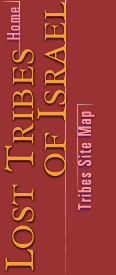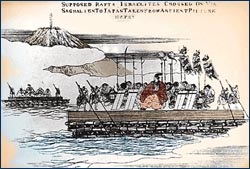
|

|
Where are the Ten Lost Tribes? Part 3 | Back to Part 2 Beyond the Sambatyon | Historical Introduction | Benjamin of Tudela New World Part I | New World Part II | The False Messiah | Tribal Groups Japan | Beta Israel-Ethiopia | Chiang-Min China
Daber: in Hebrew, to speak. Daberu: Japanese for chatting. Goi: a non-Hebrew or foreigner. Gai'Jeen: prefix for a foreigner, a non-Japanese. Kor: cold in Hebrew. Koru: to freeze in Japanese. Knesset: Parliament in Hebrew. Kensei: Constitutional government in Japanese. These are among the thousands of words and names of places with no real etymological meaning in Japanese. And they all correspond with Hebrew words. Even the Kings have similar names. The first known king of Japan, who was named Osee, ruled around 730 BC. This king has been identified with the last king of Israel, Hoshea, who died around the same time, at the time of the Assyrian exile of the ten tribes from Israel. The holy Japanese shinto temple strongly recalls the ancient holy Isrealite temple, which housed a holy of holies section and several gates. Several artifacts in Japan have been traced to Assyrian and Jewish sources, among them, a well in Koryugi with the words "well of Israel" inscribed on its side. It has also been suggested that the carts of Otsu and Kyoto are of ancient biblical origin, as they are different from any others in Japan. Might the ancient Israelites and their wives and children have been conveyed to Japan in these carts? Among the Samurai sect, there is a tradition that their ancient ancestors came to Japan from western Asia around 660 BC.The name 'Samurai' recalls 'Samaria'. And to which tribe do the Japanese belong? There are those who claim that the Mikado, the Japanese emperor, is a descendant of the Hebrew tribe of Gad. 'Mikado' recalls the Hebrew word for 'his majesty the king,' 'Malchuto'.
In the latter part of the twelfth century, a legend appeared which persisted for several centuries and reached Egypt, Palestine and Europe. According to this legend, a Christian priest named Prester John ruled as monarch over a vast and wealthy Christian Empire. According to many traditions, Ethiopia was the land of the powerful Prester John's kingdom, as well as the home of the ten lost tribes. Persistent rumor had it that these African Israelite kingdoms were at constant war with Prester John, and that their armies were advancing on Rome. Who are these African-Jewish tribesmen so central to the Prester John legend? These are the Ethiopian Jews known both as Falashas, the Amharic word for landless, wandering Jews, and as Beta Israel, the house of Israel. In Ethiopia, they engaged primarily in agriculture, but were known also for their exquisite crafts and jewelry. Today, most of the Beta Israel live in the state of Israel. In the 1970's and 80's, the Israeli government airlifted thousands of Ethiopian Jews to Israel, rescuing them from political and economic distress. According to one tradition, the Ethiopian Jews are the descendants of one of the ten tribes, as their religion is an ancient form of biblical Judaism. Their religious practices are prescribed by the Orit, the Torah translated into their Gez dialect. They possess none of the post-biblical laws. Over the centuries, the Beta Israel have been connected with the tribe of Dan. This association has eased the process of their return to the state of Israel in recent times.
"Behold, These are coming from afar. These from the north and the west and these from the land of Sinim." This prophecy, spoken by Isaiah, promised the return of Lost Israelites from all corners of the Earth and from Sinim. Interestingly, Sinim is the Hebrew word for China. In fort-like villages in the high mountain ranges on the Chinese-Tibetan border live the Chiang-Min of West Szechuan. It has been claimed that the Chiang-Min are descendants of the ancient Israelites who arrived in China several hundred years before Christ. The missionary Torrance, who visited Cheng-du in the early party of this century, insisted that the Chiang-Min strongly resemble the Israelite branch of the Semitic race. He observed that several of their customs were reminiscent of ancient Israelite tradition. Said Torrance: "The plough the Chiang use is similar to the ancient Israelite plough and is drawn by two oxen, never by an ox and an ass. This in accordance with the Biblical stipulation: 'You shall not plough with an ox and ass together.'" The Chaing-Min believe in one God. During "times of calamity or acute distress," writes Torrance, "they issue a moan or cry which sounds like 'Yawei', suggestive of the biblical name of God. The Scottish missionary also claims that the Chinese conception of Sacrifice came from the ancient Israelites. Finally, Chiang-Min priests, like the ancient Israelite priests, wear girdles to bind their robes, and bear a sacred rod shaped like a serpent, reminiscent of the brass serpent fashioned by Moses in the wilderness. Images: (1-3) Maxima New Media; (4) New York Public Library; (5-6,8) Jewish National and University Library; (7) Cicada Films; (9-10) Beth Hatefutsoth exhibition and catalogue "Beyond the Sambatyon: The Myth of the Ten Lost Tribes", Tel Aviv, Summer 1991. Where are the Ten Lost Tribes? | Tudor Parfitt's Remarkable Journey Mystery of Great Zimbabwe | Build a Family Tree | Resources Teacher's Guide | Transcript | Site Map | Lost Tribes of Israel Home Editor's Picks | Previous Sites | Join Us/E-mail | TV/Web Schedule About NOVA | Teachers | Site Map | Shop | Jobs | Search | To print PBS Online | NOVA Online | WGBH © | Updated November 2000 |
 Japanese illustration depicting the raft on which the
ancient Israelites crossed over to Japan.
Japanese illustration depicting the raft on which the
ancient Israelites crossed over to Japan.
 Ethiopian women with qita, unleavened bread baked for
passover.
Ethiopian women with qita, unleavened bread baked for
passover.
 The Scottish missionary Rev. Thomas Torrance in
China, 1920s. Torrance claimed the Chiang-Min of West
Szechuan were descendants of the ancient Israelites.
The Scottish missionary Rev. Thomas Torrance in
China, 1920s. Torrance claimed the Chiang-Min of West
Szechuan were descendants of the ancient Israelites.